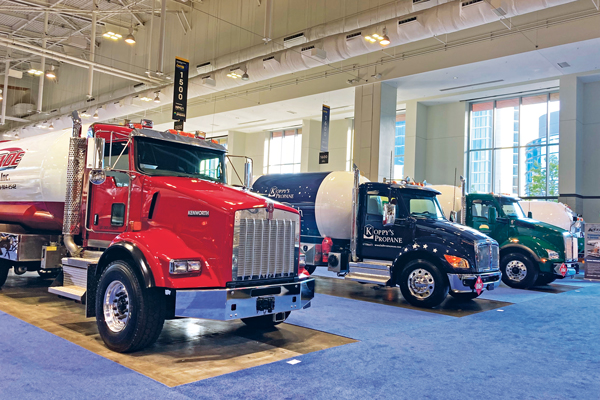Assess your vehicle fleet

Replacing an old truck with a new one can increase delivery capacity and mileage efficiencies. (Photo by LP Gas staff)
We love our trucks. A delivery truck is a high-profile representation of your propane company – not to mention an expensive one. That’s why propane dealers lavish so much attention on their trucks.
But trucks don’t last forever. The decision to invest in a new delivery truck is not an easy one to make. Issues of timing, financing, tax planning and the simple, physical need for a new vehicle must all be weighed.
The best reason to purchase a new truck is to replace an old one. When repair costs, limited delivery capacity, increasing downtime and safety concerns combine to increase your cost per delivery, it makes sense to bite the bullet and invest in a new vehicle. In a replacement situation, you are assured of good utilization of the new truck right away and should gain efficiencies in areas such as delivery capacity and fuel mileage. The time to put the replacement on the road is before your old truck breaks down in the middle of the heating season. You don’t want to get caught trying to stretch too many miles out of your “old workhorse” before putting it out to pasture.
Adding a new truck to your existing fleet involves a more difficult decision. If your trucks are all busy, and it seems your drivers are going nonstop, should you invest in another truck to ease the burden and maybe expand your customer base?
Let’s add some logic to the decision-making process. According to our 2021 Propane Industry Survey, the typical delivery truck can drop about 536,544 gallons per season. This is based on a capacity of 3,312 gallons per day (184 gallons per drop x 2.4 drops per hour x 7.5 hours), over a 162-day heating season. That means you should have a delivery truck on the road for every 536,544 gallons of propane you expect to sell.
The guesswork involves trying to anticipate how many gallons you will be delivering in the upcoming season. Your supply contracts may provide a good indication of what to expect in this regard. Still, one of your trucks – hopefully not the new vehicle – may sit idle if the winter turns out to be particularly mild.
Purchasing criteria
Here are a few additional factors to consider before making the decision to add a new truck in 2022:
Vehicle costs are up. Like everything else in life, it will likely cost you more to buy a new truck in 2022 than it did last year. A quick online review showed new bobtails in the $190,000 range and full-size tank trucks nearing $250,000.
Delivery times are extended. Supply chain disruptions are affecting truck manufacturers and companies that convert truck chassis into delivery vehicles. Even in the best of times, a new truck often takes more than a year to deliver. At present, it may take several additional months. This places more pressure on your decision to add to your fleet.
Financing costs are up. The Federal Reserve’s decision to move interest rates higher makes it more expensive to finance a truck purchase. You may need to shop around for a bank or other financing source to find the best rate. Or consider leasing.
Drivers are hard to find. A truck sitting idle because there is nobody to drive it is a terrible investment. The ongoing labor crunch has made finding and hiring drivers more difficult. A good rule of thumb to use in staffing your delivery team is seven full-time equivalent (FTE) drivers for every 10 trucks. This could be a combination of three full-time drivers and eight seasonal drivers. Keep in mind that the FTE number is spread out over the entire year. You may employ additional drivers during the height of the season and cut back during the offseason.
Fuel costs are up. With diesel and gasoline prices at record levels, buying a more fuel-efficient truck can help curb fuel costs over the length of a heating season.
Truck purchases may still be deductible. The good news is that the Section 179 equipment deduction remains in place for federal taxes. Depending on the cost of the vehicle and your company’s tax situation, you may be able to deduct the entire purchase price in 2022.
Margins are being squeezed. There is so much uncertainty in the economy and the propane market that there is almost certain to be pressure on margins during the upcoming heating season. Cash is king right now, and tying up too much of it in a new truck might leave you in a tight cash flow situation. Choosing to lease a vehicle over purchasing may be a viable alternative that frees up more cash.
Strictly from a financial standpoint, delivery trucks are not the greatest investment. You pay a lot of money for the equipment, then spend more in maintenance and operating costs. But the truck is the business end of the entire propane delivery system. Anticipating the need and timing for replacement or addition to your truck fleet will always be part art form, part calculation.
However, unless you have a delivery truck that is on its last legs and in danger of breaking down frequently, our current recommendation is to delay the purchase of a new vehicle until interest rates stabilize and there is more certainty in the propane market.
Marty Kirshner and Joe Ciccarello are partners in the Energy Practice Group at Gray, Gray & Gray LLP, a business consulting and accounting firm that serves the energy industry. They can be reached at powerofmore@gggllp.com or 781-407-0300.
















